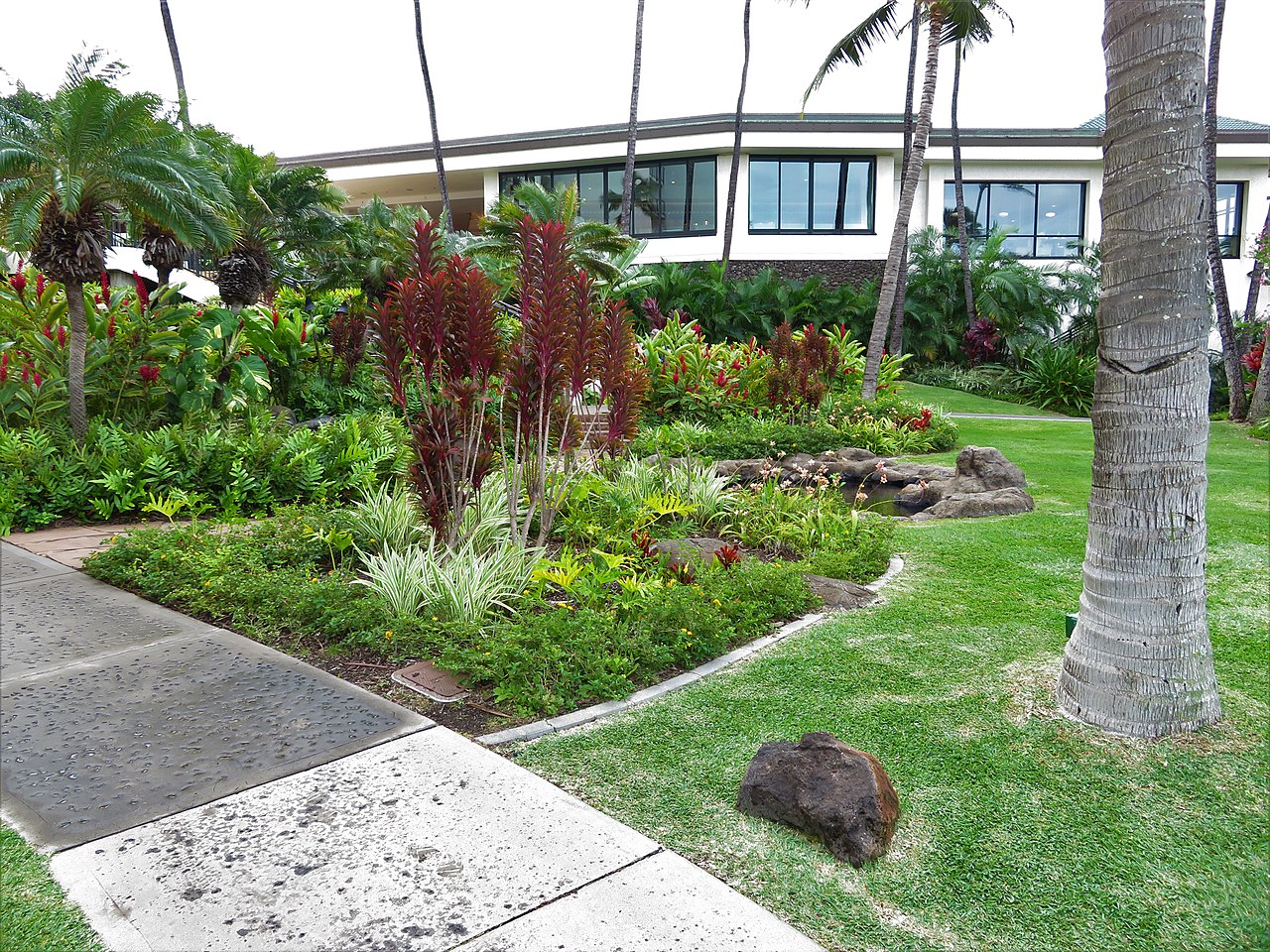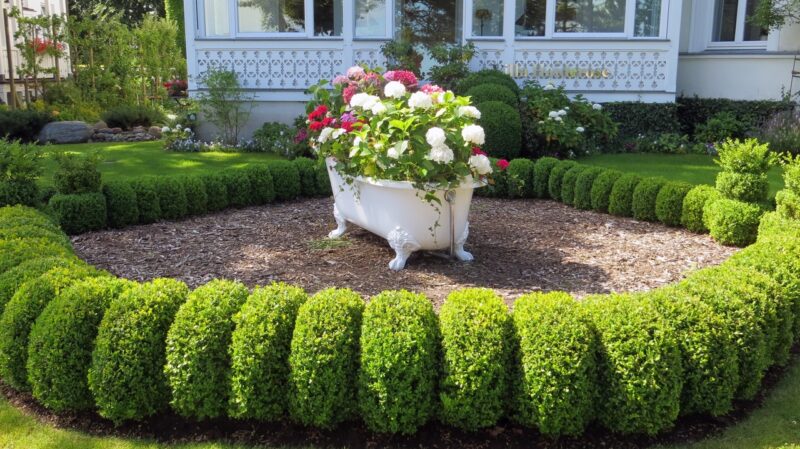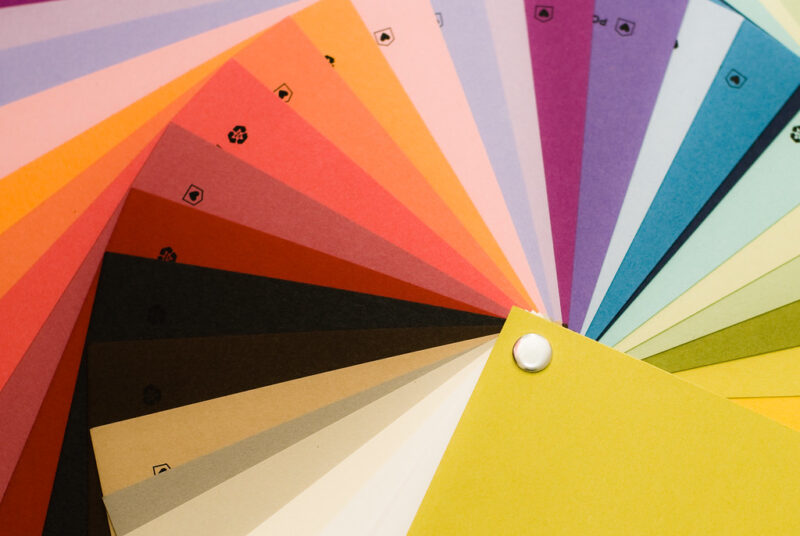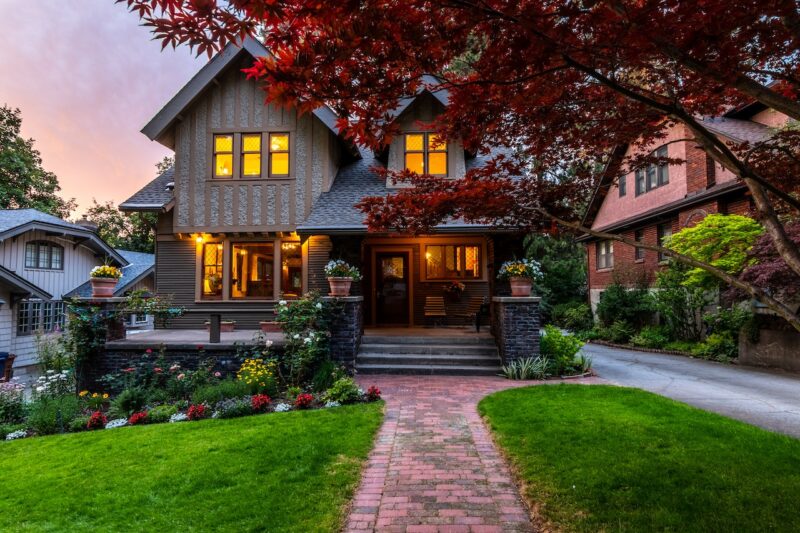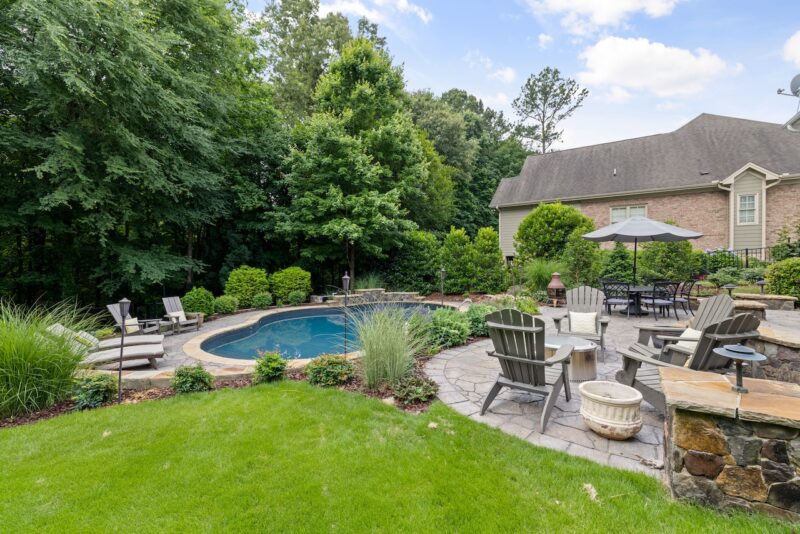Landscaping is a form of art, and art is about composition. So what exactly is composition? It is the combining of various elements and characteristics to produce an end result that is both aesthetically pleasing and functional.
Composition is about putting things together, like blending plants with hard materials, lighting with surfacing, etc., to create a whole that is greater than simply the collection of its parts. Somehow compositions combine elements that work well together.
So what makes for a good composition from what would otherwise be a random collection of objects? This is one of the underlying fundamentals of art, and it comes down to a balance of extremes.
Balance is the essence of composition because it creates interest, tension, and excitement without becoming disorienting. It is this pervasive “yin and yang”, this active interplay between brash and subtle, feature and background, coarse versus fine, which elicits emotion, and emotion is ultimately what separates an artful composition from just a collection of stuff.
To understand composition is to understand these extremes, and to play with them in a controlled and purposeful manner is the heart of landscaping.
The Art of Composition
“Harmony” is the word often used to describe a pleasing balance of the elements themselves in a composition. To understand this, let’s look at the extremes.
A landscape that is composed entirely of random and disjointed elements can look confusing or busy. On the other hand, a landscape consisting entirely of one element would be rather boring.
The proper balance lies somewhere in between. Thus, good compositions are a balance between unity and repetition on the one hand, which bring harmony to a creation, versus variation and contrast on the other, which maintains interest.
Likewise, symmetry and asymmetry are extremes. A completely symmetrical landscape, which might be characterized by geometric lines and shapes mirrored along axes, appears very formal and “man-made”, almost artificial. Most downtown skyscrapers are rigidly symmetrical.
On the other hand, the extreme of asymmetry is pure randomness, where confusion reigns and the eye cannot bring order to a composition. Even nature isn’t purely random (every plant or rock is in its place for a reason), so again we must find that happy balance between these extremes.
Light and shade are another set of important extremes. Not only do they dictate which plants can be used and how they will grow, they in themselves can be a source of contrast in a composition.
A perfect example of this is the dappled shade cast by a honeylocust tree, imparting a texture of its own on the grass beneath. Early morning shadows impart an entirely different ambiance to the landscape than the darker evening shadows.
In direct sunlight, shade is like an oasis, while in winter, the bright warming sun is most welcome. Shady areas suggest mystery, while open sunny gardens are loud and inviting.
One can look at lines and curves as being opposites of each other in a composition. Linear landscapes, which are characterized by rigid, straight lines and sharp angles (typically 45 or 90 degrees), seem formal and abrupt; in the extreme, they can be uninviting and can look too manmade.
Using curved lines in the landscape mimics the more gentle flow of nature; think of the shape of rivers, streams, and rolling hills.
Linearity is one of the major determinants of style. In fact, linearity and curvature are so starkly opposite that it is actually difficult to blend the two together, and one of the first decisions made in the landscape design process is a linear landscape versus a curved design.
Again, there is no such thing as a “correct” usage of these balances and harmonies of the design elements, no simple equation for calculating the “perfect” mix. It comes down to getting what you want from your creation, but with the recognition that the choices you make will ultimately underpin and define your composition.
Material Qualities and Characteristics
We have heard that “variety is the spice of life“. It’s obvious to us that the differences between people make us recognizable as individuals, and that it would certainly be a boring world if all houses had the same shape, or if cars only came in one color.
The trick with variety is to categorize the key elements of variation into groups such that we can study each of them for their impacts on the final composition.
Form
Our human brains intuitively try to seek out recognizable shapes in the world around us; it is one of the first characteristics that we register about an object.
Most hard materials, since they are typically artificially constructed, have a definite shape, and we can easily label them as square, round, rectangular, etc. Man-made objects tend to be visually strong, with sharp lines and clear definitions.
In the world of plants, the shape takes on a more subtle meaning, leaving some room for interpretation. We say a tree is pyramidal or rounded or columnar, a particular shrub is stiffly upright, and a ground cover forms a low mound, but different people may see these shapes differently.
Plants lend more natural shapes to the landscape, and in fact, the harshness of man-made objects can often be countered with the strategic use of plants.
In landscaping practice, form is of the highest importance. When shapes are repeated, an element of order is introduced into the scene, and a sense of emphasis and structure is created. If overused, however, repetition becomes monotonous and uninteresting and starts to look artificial.
On the other hand, contrasting shapes are often used to offset each other. The harsh vertical line of the side of a house can be softened with a rounded shrub or tree.
Smaller plant forms can be used to “anchor” a strong structure to the ground by gradually tapering height away from the object, which is one of the primary objectives of modern foundation plantings.
A particularly unique form can be used as an accent, such as a weeping tree or a shrub with twisted, contorted branches. Taken to the extreme, topiary makes as bold a statement as a stone statue, and should therefore be used exactly as such.
As a rule of thumb, the more extreme or audacious an accent is, the more it should be used as a solitary specimen rather than in groupings, and it should be offset by an increasingly muted background. Again, this is the essence of maintaining balance.
Articulation is the silhouette of one or more objects against the horizon, much like the varied skyline of a city appearing from a distance. Narrow pyramidal trees act like exclamation points on the visual horizon and break up the otherwise nondescript canopy of rounded trees.
The form of an object can draw the eye up or down; a tall, columnar plant intuitively makes you look up, while a low, squat, and rounded mound draws your eye down. This technique is often used to make your eye look either away from or towards a particular feature, where such controls are desired in the landscape.
Texture
Texture refers to a measure of the detail or subtlety of an element. It is obvious that a rocky seashore has a much coarser texture than a sandy beach, even though both are essentially constructed of the same material, stone.
In general, coarse textures are readily noticeable and lend impact from a distance, but are lost up close. Fine textures are not perceptible at a distance and typically blend into the background, but reveal a world of interest on close inspection.
When used in reverse order, however, with slightly coarser textures in the foreground, a scene can create an illusion of depth, which is valuable for making small spaces look larger.
In keeping with balance and harmony, textures can be varied to create interest or repeated to create emphasis. Plants offer a broad range of textures, from the intricate delicacy of ferns to the “in your face” brashness of a Catalpa tree, and everything in between.
Plant textures can also change with the seasons; a fuzzy tree with deeply cut leaves can change to a coarse, clubby mass of branches in winter, while evergreens tend to retain their texture throughout the year. Hard materials keep their textures across the seasons and are available in a wide range of choices.
Color
The study of color is quite fascinating. Colors function based on what is known as the “color wheel“. This is an easy tool to understand; complementary colors are presented side by side while contrasting colors appear opposite on the wheel.
Complementary colors, such as red and pink, are best used together in masses, giving flow and stability to a composition. Contrasting colors, such as blue against yellow, create instant accents, and stand out vividly, screaming to be noticed.
Red and orange are “hot” colors, making a composition seem lively and exciting, while blue and purple are more subdued, and can make things feel cool and calm.
White is certainly the most functional of the colors, and behaves differently in different circumstances; it is brilliant and clean in full light, and yet mysteriously perceptible in very low light. It also comes in a tremendous variety of shades of every other color, lending subtle variations to an already extensive palette.
Hues are also important; deeper colors are moody and emotional, while pastels are lighter and more gentle.
When looking at color in a landscape, people intuitively tend to think of flowers. Let me adamantly state that while flowers are an obvious source of color, flower color is only one of many tools available to the designer, and a landscape designed solely on flower color is fleeting at best and ineffective at its worst.
The true value of color is broader and more dynamic. It lies in the changes found over the seasons; foliage in spring, summer, and fall, flowers and fruit, and bark in winter.
Remember, colors don’t have to hit you across the head to be an integral part of a composition, a fact that many amateur gardeners tend to ignore.
Don’t overlook the value of foliage colors. There are numerous shades of green in the plant world, ranging from yellow and lime greens to bright grass greens to rich, deep greens and powdery blue-greens. When used in contrast, these shades can lend intricacy to a composition with some permanence throughout the growing season.
Furthermore, many plants have tinges of colors such as bronze, red, or gold in their foliage. Many feature variegated foliage, with artistic splashes of white, yellow or purple, adding strong interest on closer inspection of the leaves.
Some plants change colors over the season, with new leaves emerging one color, slowly changing to a summer color with time, giving a dynamic sense to the landscape palette.
And, of course, there is the rich tapestry of fall colors available to the designer, although one needn’t be reminded about these, as they tend to be quite loud and noticeable.
Above all, don’t forget to achieve balance and harmony with color. Too many random colors are definitely confusing, and don’t make much of a statement, unless you are trying to recreate a wildflower meadow or “cottage garden“.
Overuse of one color can be very emphatic, but can also become monotonous. Unlike the other characteristics, however, colors are best used either in related groups (the same quarter of the color wheel) or in opposites.
Most importantly, don’t go overboard focusing only on color as your sole tool for expression; there is an inherent beauty in using color subtly that will not be lost on your landscape.
Read Also:
- 10 Essential Fall Yard Care Tips – Preparing Northern Yards and Gardens for Winter
- Creating an Authentic Japanese Garden – But Made in North America, Eh?
- Landscaping with Boulders for a Dramatic Effect
- Landscaping Guide – Four Seasons Landscaping
- Secrets to Creating a Personal Garden Sanctuary
- Landscaping Guide – The Art of Landscaping
- Landscaping Guide – The Artist’s Palette
- Meditation Garden Artwork
Landscape Functions
Elements in the landscape have specific characteristics that can be combined to make an aesthetically pleasing composition. They can also be categorized according to their specific functions in a landscape. These are each described as follows;
Shade
Different plants cast different amounts of shade. Obviously, larger plants cast more shade, but there are other important factors to consider. For human use, especially recreational use, shade trees must have a canopy at least 6 feet above the ground, otherwise, people will be constantly walking or running into low branches.
Low-headed trees tend to use up a significant amount of real estate, especially weeping trees, and while they may be beautiful, they may not be the most prudent choices for smaller landscapes.
In the north, shade is certainly desirable in summer to cool off from the heat, but the warming rays of the sun might be of more value in winter. In such cases, deciduous trees should be used to the south of a property.
Bear in mind the ultimate size and spread of a shade tree when planning your design, as someday it may start to shade a part of the garden that was previously sunny.
Accent
An accent is an element in the landscape with a high degree of interest or ornamental value relative to its surroundings. The interest can be inherent, such as with a particularly attractive statue or evergreen topiary, or it may be fleeting, such as a tree with brilliant fall colors or a shrub with exceptional spring flowers.
Plants that have ornamental characteristics in more than one season are particularly valuable for home landscaping, especially if they are dynamic. An accent can stand on its own, or be a part of a garden or other feature.
A specimen is an accent tree or shrub that is grown solitary against a uniform, muted background which does not compete with it. Accents must be used with restraint, otherwise, they become commonplace and then by definition are no longer accents.
Articulation
Articulation is the variation in the skyline or horizon of a landscape. Since most deciduous trees have rounded or oval heads, the skyline is typically quite uniform and monotonous. This is primarily perceptible at a larger scale, for example, at a distance.
Distinctive shapes, such as the pyramids of spruce trees or the columnar forms of white cedar (arborvitae), add variety and break up the monotony. These are especially valuable in breaking up long horizontal runs such as high fences, or large blank spaces such as the sides of large buildings.
Articulation is also achieved by varying plant heights, forms, and ages at planting. Like accents, however, elements of sharp articulation must also be used with restraint, otherwise, they become a style unto themselves.
Enframement
One absolutely fascinating characteristic of large shade trees is that they can be used to frame a particularly interesting view, much in the way a picture frame borders a picture.
The result is a feeling of protection and comfort, putting things in perspective. It is particularly important in bringing closeness to an otherwise distant or open view, such as a view into an open field or onto mountains, or bringing an open sky into perspective, which would otherwise look remote and daunting.
Proper enframement is achieved only with large, high-headed trees, and is really a plan for the distant future, being fully effective only when the trees have grown up.
Gardens and Borders
When most people think of landscaping, they think of gardening. The truth is that gardens and borders are only small, albeit important, constituents of a landscape.
A garden is a grouping of specially selected plants, arranged in a precisely planned manner for an intended purpose or effect, sometimes with small hard elements integrated as well.
Different types of gardens include foundation plantings, island beds, raised planters, and borders, which incorporate elements ranging from flowers to shrubs and even small trees. They are typically high maintenance, although shrub borders are the least demanding of the lot.
Like accents, they should be used with restraint and in proper proportion to the overall plan. The good news is that you can create a perfect landscape with no gardens at all, or with vast amounts of property put into gardens; they simply end up reflecting the tastes of the homeowner.
Windbreaks and Shelterbelts
When you drive by fields in the country, you can’t help but notice the ubiquitous windbreaks and shelterbelts which separate fields and surround homesteads.
They serve more than just an aesthetic purpose; by blocking drying winds, they trap heat and moisture and actually modify the local climate within their protection. They also trap snow in winter, prevent wind damage in summer, and provide a refuge for wildlife.
They are absolutely essential on the open prairie; without them, even the hardiest of plants would have difficulty surviving.
This same principle can actually be applied in smaller urban landscapes, employing windbreaks to deflect wind, provide shelter and even create favorable microclimates, permitting plants from warmer zones to grow in an otherwise inhospitable climate.
Detail
These are the elements that you see and appreciate up close, and are as important in the landscape as trees, paths, and accents. For a landscape to be personal as well as functional, it has to offer interest both at the large scale and at the “up close and personal” level.
Detail is the reward for stopping to smell the roses, the small surprises in your art that are only noticed or appreciated on close inspection.
Detail elements can range from significant structures such as arbors, pergolas, and benches to the most delicate rock gardens and unique plants.
Detail can also be created by adding a vertical dimension using vines and climbers, or strategically locating points of interest such as container plants or hanging baskets on the patio or front porch.
All of these are the little touches that finish the landscape and add the warmth that is otherwise lost at a large scale of design.
Background
At first, the background seems like an obvious concept; if you want to highlight a particular accent or feature, then you provide it with a plain, neutral backdrop.
However, you really need to think about what this means; you can’t use flowery trees or purple-leaved shrubs in the background, as they will compete with the feature being highlighted, thus defeating their purpose.
Accents are emphasized when the background is uniform, repetitive, and consistent in texture, form, and color. A background must constitute the bulk of a landscape to properly highlight accents.
Hard materials can also make excellent backgrounds, such as fences, walls, or buildings. In all cases, they must be able to highlight the feature of interest, rather than detract from it.
Enclosure and Screening
One of the most important functions in landscaping is the segregation of the landscape into functional rooms using both artificial and living walls as dividers.
These can range from low 2′ high boxwood hedges to fences and lattice screens to rows of towering columnar trees. The principle is the same; using elements to isolate one area from another.
Low hedges or small stone fences are used to create visual barriers; they actually are not protective or impenetrable in any real sense, but they give an impression of separation, which is often enough to delineate a functional space.
For tight areas where space is at a premium, hard fences or walls achieve enclosure without taking up much valuable room. Where there is more space available, barriers or hedges of plants are highly recommended.
Screens can also be used to block unwanted external views, maintain privacy, and even block out undesirable noise from traffic. Note that most enclosure materials require some degree of maintenance, whether pruning of hedges or painting of fences.
Groundcover
When people think of groundcovers, they immediately think of grass. There is no doubt that grass is a premium groundcover because it is durable, uniform, hardy, and attractive.
It is also very high maintenance, and for that reason, many are now looking to low-maintenance alternatives, and are surprised at just how many alternatives there are!
These can include plants with special groundcover characteristics, such as spreading cotoneasters or junipers, as well as hard surfacing materials such as decorative rock or colorful bark mulch.
They require some maintenance such as weeding and watering to get established, but once established, they are generally maintenance-free. When planning your landscape, be sure not to only think of grass when you need a ground cover!
Orchard
Orchards are any parts of the landscape reserved for plants that produce edible fruits, nuts, or berries. These plants have been selected for optimum fruiting characteristics, sometimes at the expense of ornamental characteristics.
They require adequate room for air movement to prevent disease and fruit damage, and some degree of shelter to protect the fruit from drying and damaging winds.
They can be the formal growers’ orchards with evenly spaced rows, but often just a few strategically placed fruit trees can bring the bounties of an orchard to an urban backyard.
Landscaping Zones
The typical home landscape can be divided into major zones, each characterized by a specific function, purpose, and one or more underlying design principles. Each of these areas requires its own unique strategy and approach for optimum functionality and value.
The focus of the modern landscape is almost universally the house. It is our prized possession, and pretty well the center of our lives. Since the basic purpose of a home landscape is to extend the functionality of the home into the yard, the house becomes the frame of reference for the rest of the landscape.
The home dictates a basic separation of the yard into a public area and a private living space, and this is integrated into the landscape plan.
The public area is part of your home and landscape that is generally seen by the passing public. It is the fundamental trademark of your home, the first impression made on visitors and passersby.
In the same manner that your home frontage typically has the most attention to detail and expensive finishes, your front landscape is primarily designed to be seen and enjoyed by others.
Here, adherence to proven styles and basic principles is more important than your artistic liberties, although that is not to say that you cannot be creative and individual.
The modern public design features a functional but decorative front entranceway that is warm and inviting to guests without being too busy.
A foundation planting is used to shield the base of the home to some degree but is generally not very high maintenance. Only a select few accents are used, maybe just one or two for the typically urban lot, but these should be the best specimens that you can fit into your landscape.
Here, as a rule, restraint is in, and wild abandon is out. Everything is placed with a purpose; if you can’t identify a specific purpose for a particular element, it probably shouldn’t be there.
Most importantly, since your home is the primary interest of your visitors and guests, the public landscape should accentuate and emphasize the home, rather than compete with it.
In sharp contrast, the private area of your yard is yours to do with as you feel. It is typically located out of public view in the back part of your yard and is often screened from intruding views, although this is not a requirement.
Here, you are free to express yourself to the fullest, and it is here that you will find detailed garden beds, vegetable gardens, as well as most of the utilities and storage areas. This is also your personal “human” space, where you do your entertaining, play with the kids, or partake in your favorite hobbies.
This is the part of your landscape reserved for you, and the special friends you choose to invite into your world space.
Traffic ways tie the various elements and “outdoor rooms” together in a harmonious yet functional way. The driveway leads the car into the garage or parking space.
Paths and walkways guide people from one area to the next, leading them past points of interest, exposing particularly scenic views, and keeping people in designated areas and off the grass and out of flower beds.
They are constructed of durable surfacing materials which retain harmony with both the chosen landscape style and the home.
Techniques of the Masters
The basic landscaping principles are in themselves a means to a sound composition, the tools that guide the artist to a cohesive creation. However, the best landscape designers know some tricks that put that little bit extra into the very best of landscapes.
These are worthy of careful examination to see if they can be incorporated in some way into your landscape design.
Flow and Connectivity
As the individual “rooms” of the landscape are designed, it becomes critically important to link them together in a logical manner.
Just like the hallways join the various rooms of your house, so do walkways and paths encourage, whereas conversely barriers, hedges, and walls discourage, the flow of people from one room to the next.
Pathways can be used to direct the flow of people as you see fit and should be clear and well-delineated.
Barriers and enclosures prohibit movement between certain areas, such as keeping the kids out of the storage or utility area or keeping the pets in their designated part of the yard.
This is further considered in the bubble planning stage as described later, but it is critical to note that a good design takes traffic flows into consideration from the start.
Mystery
Humans, by their very nature, are curious. The shortest path between two points may be a straight line, but a curved or wandering path leads people into various regions of the yard where you have staged points of interest or particularly favorable views.
Taken to the extreme, you can actually plan a traffic way to hide various parts of the yard, only exposing them as the traveler follows the curves and eddies of the path.
Humans like surprises, and locating a small point of interest around a corner or screening a shrub is intimately rewarding to people. It’s like a roller-coaster ride for the senses!
Perspective and Illusions
We are familiar with the sleight of hand tricks used by so-called “magicians” to convince us that we are seeing something that is actually not the case. The same technique can be used in landscaping to make things appear different from what they actually are.
A long, narrow yard can be made to look wider by locating coarser plants up close, placing low cross-wise barriers, and keeping the sides clear and free.
On the other hand, strong lines out to the distance will make the yard appear even smaller than it is.
A tall tree looming over a small house will make the house seem even smaller, while a small tree beside a large two-story house will make it look even taller. Straight lines make features on the horizon appear closer, while curves tend to push things into the distance and make a space look larger.
Tall walls in a narrow space can make us feel claustrophobic, while short “false” fences still get the message across to keep out.
The Third Dimension
We tend to think of our properties as spreading out across the land, but we often forget about the third dimension when landscaping, essentially “up“.
Good landscape designs make effective use of the vertical dimension, incorporating a pleasing blend of articulation and enframement of the horizon.
Vines add depth and character to homes, arbors, and other man-made structures, giving life to walls and softening rough or uniformly bland materials. Shrub borders face down harsh vertical walls and fences, and act as “visual railings” for paths.
Detail elements located above the line of sight draw the eyes upwards and enhance the apparent volume of the space, an effect which is further enhanced by the use of strong vertical lines such as the slats of a fence.
Variation in the third dimension adds an even higher degree of interest than is possible with a simple two-dimensional design and gives volume to a concept. It can even be used to add visual mass and interest to a small landscape by accommodating plant material where it might not otherwise have been.
Perla Irish, who is more familiarly known as Irish, is the Content Manager at newfld.com. She loves following trends around home and garden, interior design and digital marketing. Through this blog, Irish wants to share information and help readers solve the problems they are experiencing.
